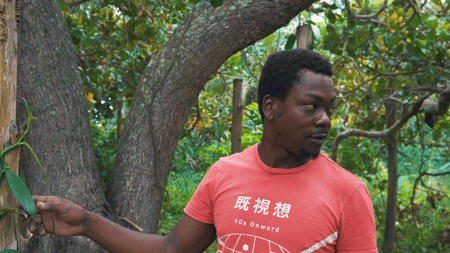
Kenya’s Potential in Vanilla farming still untapped
By Malachi Motano
Andrew Simiyu grows Vanilla, a crop most farmers in the Country have not considered farming. He started its farming in 2018 in a forty (40) acre piece of land in Mwapala, Kwale County. Though still waiting for the first harvest, he believes that he has ventured into a goldmine, since just a small bin of vanilla seeds is sold at Kshs.250 and with value addition can go up to Kshs. 1000. A single tree can earn a farmer over Kshs. 16000 per harvest.
When I began vanilla farming in 2018, the information about the crop was so hard to get. I was unable to find cuttings to plant locally and I had to source them from vanilla farmers in Uganda and Zanzibar. Unfortunately I even lost half of my initial vines. At least today I am able to nurture 500 vines and I am expecting to harvest the first batch of seeds at the end of the year,” narrates Andrew
Simiyu.
He says Vanilla beans are the second most expensive product in the world, after saffron, due to its incredible flavor “Scientists have found more than two hundred and fifty natural flavors and aroma enhancers in vanilla.
They are also expensive because oflong duration they take to mature. “It’s hard to grow. Vanilla take many years (2-4) to mature, with their flowers blooming only once in a year and have to be pollinated that very day for the plant to produce beans. Vanilla isn’t a native plant in most areas where it is grown so there are no bugs or birds capable of pollinating its flowers. The flowers therefore have to be pollinated by hand since they have small flap of plant tissues known as rostellum, separating their male and female organs hence do not self-pollinate. The pods need several months to cure after harvesting, making the whole process to be time-consuming” says Simiyu.
Its orchids produce a dark brown seed pod that produces vanilla extract, one of the main flavors for yogurts, ice cream, chocolate, cookies, tea, cakes, and perfumes. Vanilla pods need several months to cure after harvesting. “Post-harvest curing requires scorching sun. It takes vanilla six to eight months to cure. It also requires ample and adequate rainfall and extremely warm temperatures for optimum growth. Beach land and low altitude lake regions provide perfect environment for vanilla plantations to flourish,” he explains. Vanilla growing conditions include hot and humid weather. It also does well on sandy soil with clay and river silts combined.
Due to high demands, Vanilla beans are prone to theft. Farmers sometimes pick vanilla pods while still green for fear of theft, unfortunately this result to lower quality hence fetching lower prices.
The beans start drying immediately after the harvest and turns dark brown, oily and flexible then develop a powerful and enticing fragrance that is also known to chase away insects and pests.
The cost of a single Vanilla cutting is Kshs. 1o00 or Kshs 800 while bought in bulk. The stems of the first set is normally cut off after about 2½ years when the vanilla is about to flower. This gives the farmer another vine, and also spurs flowering.
Planting can be done first in nursery or directly at the farm within three weeks or one month. The young vines are vulnerable hence need to be planted in a controlled area for easy monitoring. The area also needs to be well manured and shaded. Transplanting is done once when the vine starts showing signs of new growth.
Just like passion fruit, Vanilla vines need support and so should be planted next to posts or trees. Its vines mature faster when they creep up on trees since this enable them to feed from the trees barks. Trees also provide a natural canopy that shades the vines. The tree cover should. However, not be too dense, as vanilla doesn’t do well.
When using posts like in the case of intensive farming, it is advisable to create about 1 ½ meter spacing in either direction to give enough space for each vine to freely grow and allow easy access when carrying out fieldwork.
The vines should be left to creep up on a tree or post only to a reachable height, to enable manually induced flowering. The vine can be looped into the mulch if it is getting too tall, leaving the tip up, and it will regenerate and creep up once again.
With his 500 vines in flowering period, Andrew wakes up at 5 am before it’s too hot and while the flowers are still fresh to manually pollinate them by detaching the film that separates the male and female gametes using a toothpick
Vanilla flowers last a day, they open just before sunrise and wilt before nightfall. If they are not pollinated during this short window, they fall from the plant, which is a seed worth at least Sh250 that will not be harvested until the next flowering season.
“Another benefit for vanilla is that, unlike other high value crops, it demands little upkeep. Every three months I clear any dense grass growing around the vines, add manure and mulching” says Andrew.
According to agronomists, farmers in the highlands, can to grow vanilla in greenhouse because of the specifications required.
Vanilla is harvested only twice a year with a vanilla tree bearing up to 80 beans. Since the crop takes too long to mature despite the country possessing the right conditions for its cultivation ready market locally and export, most farmers shy away from growing vanilla.
Vanilla has two commercial species Vanilla pantifolia also known as V. fragrans and Vanilla pompona schiede. A third specie known as Vanilla tahitensis is believed to have originated by crossing V. planifolia and V. pompona stock in a laboratory.

